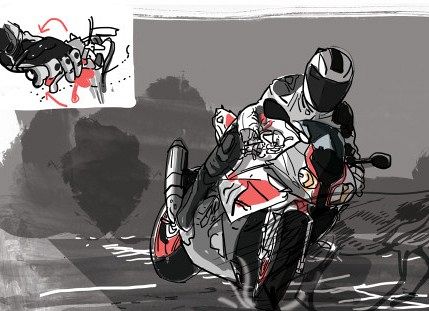Each street-riding priority moves to the front of the list as your circumstances change, but this single priority should always be first: mastering your bike-control skills.
When the worst happens and you need to get your bike stopped, or change your line, or hit that narrow gap, what you do behind the handlebar must be correct. And correct action depends upon correct practice. You must train your mind, eyes, and muscles to do the right thing at the limit of whatever traction you have. So let’s talk about what you should practice on every ride and bike you own.
1) Braking
I recently asked Yamaha Champions Riding School (ridelikeachampion.com) instructor Ken Hill what percentage of our Champ School students could stop their bike at its maximum stopping ability, even after practicing during our brake drill.
“Maybe one percent, maybe,” Hill replied.
So guess what? That means you (yes, you) need to work a lot harder on your emergency braking. Begin each brake application with an initially light squeeze on the lever to allow the fork springs to collapse controllably and the front contact patch spread out as weight transfers forward. This initial squeeze can (and sometimes must) happen quickly but never abruptly. Find the difference by experimenting at a walking pace on every bike you ride.
Add as much rear brake as your bike can handle. For sportbikes, that’s almost zero as the rear unloads due to weight transfer. For Gold Wings, it’s significantly more due to its weight balance and longer wheelbase. You will know only if you practice.
After loading the fork springs and front tire, stay focused on your right-hand fingers and front tire; that’s what counts. Don’t lock your elbows, but be ready to load your arms and hands. Keep squeezing until you hear the tire start to yowl, signaling that it’s near the point of lockup. Locking the (warm) front tire of a sportbike will cause the rear tire to leave the ground; lock-up on a less-sporty bike will skid the front. Don’t be afraid of either situation because you must always add pressure in a linear manner! And whaddyaknow? The front tire locks in a linear manner, giving plenty of warning to be easily fixed with less brake pressure. Anytime you grab, stab, or hammer, at the brakes you will have trouble and eventually pain.
The stab and grab hurts you in an emergency because the fork springs have no time to load and gain energy to hold up the bike. They collapse and, when bottomed, the front tire locks. When you practice—every ride, on each bike you own—always include a smooth initial-brake application. Then squeeze harder depending upon the situation. That way, you eventually may become part of the 1 percent who can stop their bikes in the absolute minimum distance.
2) Steering
Roadracers face few emergency situations; they know what’s coming next and they use body position to help steer their bikes. Not so true with street riders, who need to understand and practice “countersteering,” the application of pressure on the inside bar to turn the bike. You need to get a feel for how sudden pressure “snaps” the bike, how mild pressure “veers” it, and how pushing on the inside bar or pulling on the outside bar accomplishes the same thing.
It’s not enough to understand this in theory: You must get out and see what different pressures do because you might need an aggressive push/pull to dodge the spare tire that suddenly appears from under the UPS truck.
Can you thread your bike between the Bott’s dots? Can you ride exactly on the white line for a mile? Can you just skim the Bott’s dots with the left edge of your tire? The right edge? Can you bring your bike to a stop mid-turn in a deserted parking lot? From what speeds?
Can you go from yellow line to white line, and back, in the middle of a sweeping corner? Remember the saying, “You go where you look.” It all starts with your eyes.
All these questions relate to this: Are you truly in control of your bike? When traffic stops and the pickup locks its brakes behind you, can you brake and steer your bike between the cars stopped ahead of you?
Countersteering with bar pressure is a much more subtle art than new riders would ever guess—just like everything else in this sport when done well.
How subtle? Do this: Get your bike out on a deserted road at highway speeds, take your right hand and put it in your lap, and reach across with your left hand to operate the throttle. Not only are you operating the throttle, but you’re steering too. See if you can change lanes and place the bike where you want. The pushing and pulling will really become clear.










24
Comment